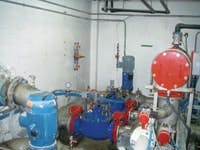Donnacona, Quebec, Canada, is an industrial town just west of Quebec City. The town’s water treatment plant was built in 1969 and has since undergone three major retrofits: new high-pressure pumps and an electrical upgrade in 1995; a filter bottoms change in 2000; and a river water intake upgrade in 2005. The plant includes conventional treatment for coagulation, sedimentation (pulsator), filtration (sand filters) and disinfection (Cl2). The raw water pumping station is 1.5 km away from the plant and includes two single-speed pumps.
To ensure compliance with the latest drinking water quality regulations, the city decided to modernize the plant in 2008. The treatment process was reviewed and it was determined the pulsators and filters needed to be dismantled and replaced with fine screening, a new coagulation chamber and a new ultrafiltration membrane filtration step, the Zeeweed 1000.
Before undertaking the modernization, the potable water tank level was controlled by manipulating the raw water flow through a 14-in. butterfly control valve. Accurate level control of the potable water tank was not absolutely required; however, the operators complained about the lack of valve controllability, especially at low flows. It eventually ended up being operated in manual mode. The poor controllability and the fact that the valve openings were too small led to wear of the internal components of the valve. This situation was tolerable, given the dampening effect of the large volume of water contained in the pulsators.
Better Level Control
With the advent of the new water treatment process, however, water was to be fed directly from the contact chamber (around 12 minutes in retention time) to the membranes. In addition, the fine-screen washing and membrane back pulse cleaning would generate sudden raw water flow variations.
“It was clear that a better level control solution was required just ahead of the new membranes,” said Alain Gravel, process engineer for Dessau Eng., the chosen engineering consulting firm for the job. “Furthermore, the control philosophy rec- ommended by GE Water & Process Technologies was based on the control of the water level in the distribution channel feeding the membranes. For cost reasons, installation of variable-frequency drives on the raw water pumps was not an option.”
The raw water flow varies widely, between 100 and 1,200 gal per minute (gpm), which results in a large head difference delivered by the single-speed pumps. Therefore, the pressure range available at the plant inlet varies between 10 and 58 psi, with a low back pressure available (less than 10 psi) for the valve. This translates into a pressure range drop across the valve of 2 to 53 psi and represents a tough job for most valves. The chosen valve had to feature a very low pressure drop when fully open and still be able to operate without cavitation when the pressure drop was high.
Preventing Cavitation
Simulations have shown that cavitation occurs below 1,000 gpm with butterfly valves. Two butterfly valves in a series are better, but still fail to properly drive the bottom half of the flows. For this reason, a butterfly valve was not an option; therefore, different configurations of globe valves were considered.
“Our recommendation was to go with an arrangement of two 8-in. hydraulic globe valves in parallel with one of them having an anti-cavitation cage,” said Daniel Forest, manager for Provan Control Associates, which supplied the valves. “For this, Singer Valve’s Models 106-PT-4SC-AC and 106-2SC-PCO were the best for the job.”
On low flows, there is enough inlet pressure to cause cavitation; however, on higher flows, the inlet pressure drops to a point at which it is hard for the anti-cavitation valve to operate because of low differential pressure. A dual-chambered solenoid control valve was supplied for this application to account for the changes in upstream pressure.
The control panel is programmed to receive a flow setpoint from the central control system that manages the level in the distribution channel. (Note: The panel also can receive the level setpoint if required.) The level is controlled by manipulating the feed flow (cascade control). The operator sets the flow setpoint and the controller adjusts the flow to ensure that the required level is maintained in the distribution channel.
On low flows, the controller guides the anti-cavitation valve depending on the setpoints of the level and flow controllers. When the anti-cavitation valve reaches a set position and the flow setpoint has not been achieved, the control- ler switches to the 8-in. Model 106-2SC-PCO and controls the valve. When the setpoint is lowered where the 106-2SC-PCO valve position is below the set position, it is fully closed, and control resumes on the anti-cavitation valve.
The valves were installed last fall and have been in operation since December 2011. Given the staging of the work activities, the plant has operated the valves to maintain the level in the potable water tank. When the last membrane train is ready, the valves will control the level in the membrane distribution channel as planned.
“The installation and operation has been smooth and without any issues, so we are very pleased to have chosen Singer Valve’s solution,” said Alain Martel, Donnacona’s director of technical services and environmental health.
Download: Here


